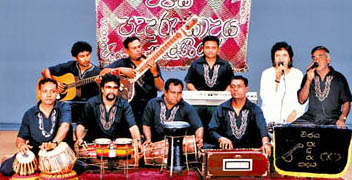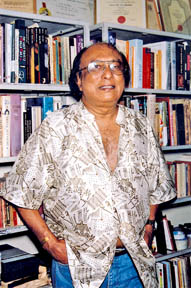Cultural orthodoxy and popular Sinhala music
Dr. Tissa Abeysekara
Culture: This is an English version of the Convocation Address
delivered in the afternoon session of the First Convocation of the
University of Visual and Performing Arts, Colombo, held at the BMICH, on
August 04, 2007.
|

Art cannot be evaluated or interpreted in terms of culture |
The creative act, if it is to be genuine, could never be part of a
cultural agenda. A work of art is never born out of a desire to enrich
culture. This may happen in time to come after the product comes into
existence, but not by any conscious design at the moment of its origin.
Culture is an evolutionary process, and in that evolution, which is a
ceaseless progression, there is integration and rejection. Those that
are integrated become part of that culture. It is only then that they
qualify to be artifacts. But that takes time. Art, or the products of
creative enterprise therefore, can never be weighed and considered, nor
evaluated or interpreted in terms of culture.
There are those, and they are of every country and every age, who
attempt to codify culture. They presuppose that culture is an unchanging
matrix to be officially determined, and then perpetuated, promoted, and
protected as something inviolate. Culture as defined by these mandarins
is an entrenched clause in the constitution of public life.
|

Dr. Tissa Abeysekara |
In such sad circumstances, art becomes the first victim. The total
and unconditional freedom required for the meaningful exercise of the
creative act is withdrawn. Such mandarins are referred to in Sinhala
colloquial parlance as ‘Pothe Guras’.
This has to be explained even briefly, because that term encodes an
important attitude in our public life towards art and social morality.
The term ‘Pothe Gura’ refers to the Narrator in the folk theatre form
called ‘Nadagam’ which comes from the Tamil word Nattakoothu’. He reads
from a prescribed text, which never changes from performance to
performance. It is a fixed libretto.
Tradition
Performance, in the popular tradition of Eastern art, or perhaps even
in the West before certain recording mechanisms came into existence, was
always live, improvisatory, and never to be repeated in a fixed and
prescribed form. A vocalist singing a raag always improvises like a jazz
musician and his recitation can never be recollected and repeated note
by note.
Therein lies the magic of performance; non-duplicative and one of its
kind; hence the note of sarcasm when someone is referred to as ‘Pothe
Gura’. He is a pedant, a man with no originality, one who lives off
texts, and therefore with no imagination; a fossil, out of step with
living reality.
Of all the expressions which sensor the shifts in public and
collective taste, dress codes or fashions and music come first. In the
drift towards a global order transcending barriers of culture and
language what better symptoms are there than the denim and the guitar.
Originating in the rock culture of the late fifties, when Bill Haley and
his Comets and then the Elvis Presley phenomenon burst upon the music
scene, the guitar became the sound of youth all over the world.
George Harrison of the Beatles was yet to try plucking the sitar, and
Ravi Shanker had still not completely won over the west, but it was a
time when the introverted musical systems of the world were opening out
towards each other.
A synthesis between eastern and western musical forms had already
been achieved at a very basic level by the film musicians of Bombay and
Madras. Listen to the songs of Naushad Ali in the Bombay films of the
forties, like “Babul”, “Deedar” and “Dastan” and the hybrid
orchestrations of the composer Papanesan Sivam for the phenomenally
popular Tamil movie, “Chandralekha” and you could hear a veneer of
western musical flavour in the orchestration, and in the melody lines,
the vertical forms of western melodic structures.
Rhythms
Latin-American and Caribbean rhythms popularised during the war years
by musicians like Xavier Cugat and Perez Prado were seeping in too. This
drift in the popular music of India had begun much earlier in the kitsch
of the Parsee theatre of Bombay (Mumbai) and perhaps in a subtler and
more tasteful manner in the innumerable compositions of Rabindranath
Tagore collectively referred to as Rabindra Sangeeth.
There were two immensely popular melody makers, Rai Chand Boral and
Khemchand Prakash who continued this hybrid genre in Indian films of the
mid thirties. However, it was after the war and especially in the
fifties that the drift gathered momentum.
Curiously, this was precisely the time that the musical practice in
Sri Lanka - Ceylon then - was being locked through official policy into
a closed circuit.
The story which I am trying to recount today, begins with the
infamous Ratanjankar Audition, whereby a reputed scholar of Indian
classical music was brought down by the authorities to audition and
grade Sinhala vocalists. This was in 1952, and the move was strongly
contested by a powerful segment of the Sinhala music community, headed
by the most popular and leading composer/singer at the time, the now
legendary Sunil Shantha.
The background to this episode could be reconstructed from references
in the Administrative Reports of the Director General of Broadcasting at
the time, M.J. Perera. In his report dated May 1953 for the year of
review 1952, under the chapter on Broadcasting, the Director General
makes the following statement:
“During the year under review the most important event that took
place in the Sinhalese Section was the re-auditioning of artistes by
Professor S.N. Ratanjankar from Bhatkande University. His visit aroused
a good deal of controversy among musicians”.
Controversy
The Sinhala newspapers of this period are full of this controversy.
Reading them it is quite clear the majority of Sinhala musicians of
the time did not approve of this audition. Why was it held in the teeth
of such opposition? Who decided to get down Professor Ratanjankar? Who
took the decision to go head with it amidst such controversy? If the
majority in the Sinhala music establishment were campaigning vehemently
against the audition, as the newspapers so clearly indicate, whose
interests did it serve? There is no Sessional Paper tabled in Parliament
on the matter.
This means getting down the Indian specialist was not part of any
specific governmental policy, nor did it seek any such sanction. It is
then safe to conclude the decision was purely a matter of internal
administration of the Department of Information, and more specifically
of Radio Ceylon.
There is a clue however, in a letter M.J. Perera wrote to the CDN of
Tuesday, June 18, 1991, reacting to certain observations I had made on
this issue in a series of articles I wrote to the same paper on the
career of Sunil Shantha , and how it was terminated tragically by the
reactionary policies of the Sri Lankan musical establishment.
“The recommendation could,” says Perera in his article, “quite
possibly have come from the Sinhala Programmes Advisory Committee”.
Re-graded
Going by his own circulars and administrative reports I have had the
opportunity to peruse in the seventies, Perera shows much official
enthusiasm for implementing the recommendations of this Advisory
Committee.
In a book published by Dr. Nandana Karunanayake in the late nineties,
“Broadcasting in Sri Lanka - Potential and Performance” there occurs
this observation: Professor Ratanjankar re-graded the artistes on the
basis of auditions conducted by him.
M.J. Perera was instrumental in inviting Professor Ratanjankar and
took unusual interest in and commitment to improving the quality of
Sinhala music”. (Chapter 11/P. 291)
Great passion
It is important to note that among the members of this Advisory
Committee for Sinhala programmes, were Professor Ediriweera
Sarachchandra and Lionel Edirisinghe, two of the most ardent champions
of North Indian classical music.
The latter became the first Head of the Government School of Music,
newly constituted as a section of the Government College of Fine Arts,
in 1952. Professor Sarachchandra’s great passion for the Raaghadari
tradition of music is too well known to be elaborated here.
In 1952, the same year of the Ratanjankar Audition, Radio Ceylon
announced the formation of a station orchestra, and it was conditional
that henceforth all recordings both vocal and instrumental, for
broadcast use this orchestra. What is of special relevance to the point
I wish to make, is the instrumental composition of this orchestra.
In the 1952 November issue of the Radio Times, the official magazine
of Radio Ceylon, there is the following item boxed and displayed
prominently in its front page.
“The members of the Sinhalese orchestra and their instruments are:
Edwin Samaradiwakara(Leader), sitar, esraj, sarode, tarshenai, and
allied instruments; Sadananda Pattiarachchi, esraj, dilruba and tabla;
A.J. Careem, Clarinet; Edward de Silva, Tampura, tabla and kole; D.D.
Danny, flute; J.A.E Perera, tabla; M.A. Piyadasa, Violin; Ibrahim Sally,
drums (dholak, tabla taang, kole)”
Comment
In his article in the Ceylon Daily News, referred to, before, M.J.
Perera, makes the following comment: “The orchestra was not very large
at the outset and only the essential instruments could be accommodated.
” It is clear then that, those considered “essential instruments”
were, with the exceptions of the violin and the clarinet, exclusively
those of the Indian musical tradition.
It is a clear reflection of the thinking behind the steps taken by
the authorities, for, what they claimed to be, ‘the development of
Sinhala music.’ This was to confine Sinhala music to an exclusively
Indian base.
This policy was once again very specifically stated by M.J. Perera in
an Administrative Report on Broadcasting for the year 1954, submitted by
him in his capacity as Director General of Radio Ceylon.
“It was generally agreed that Sinhalese music is in need of greater
development and that more students should be encouraged to go to North
India for serious study. For this purpose it was suggested that the
Ministry of Education should offer scholarships annually for the study
of music in recognised institutions in North India.
To be Continued
|

